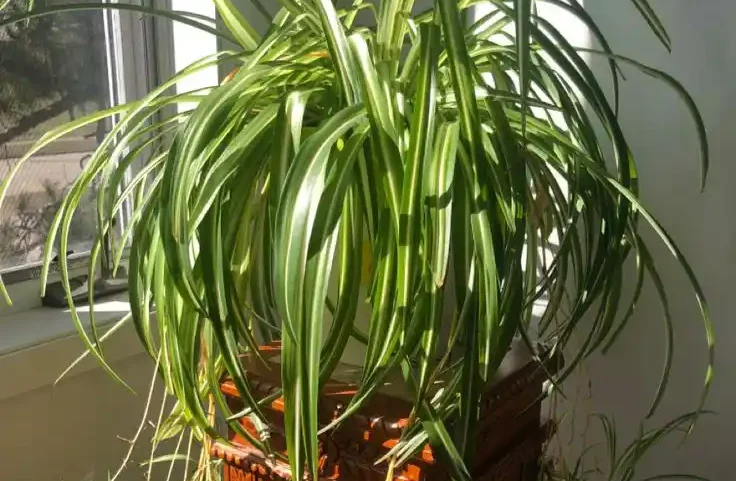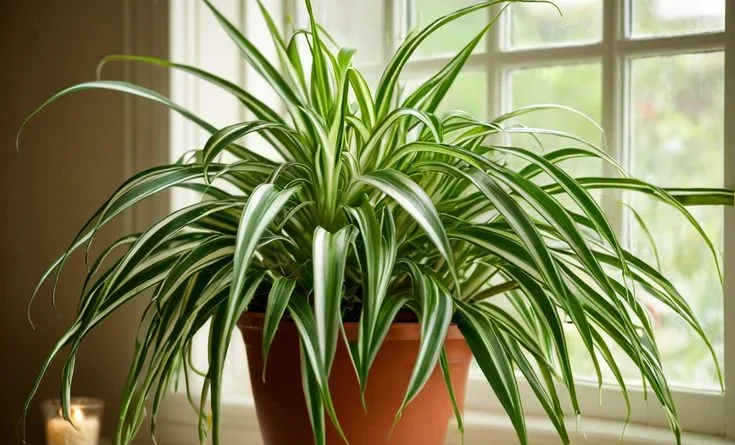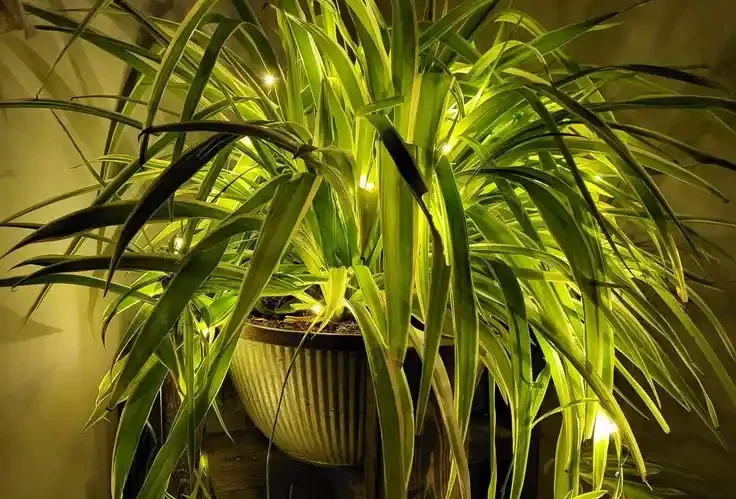How to care for a spider plant indoors is one of the most common questions among plant enthusiasts, especially beginners. Spider plants (Chlorophytum comosum) are popular for their elegant leaves, air-purifying properties, and easy maintenance. With the right care, they thrive indoors and bring a refreshing touch of greenery to your home.
In this guide, you’ll discover everything about watering, lighting, soil, fertilization, and pruning. By following these tips, your spider plant will remain healthy, lush, and vibrant year-round.
Why Choose a Spider Plant as an Indoor Plant?
Spider plants are resilient, adaptable, and perfect for beginners.
According to NASA’s Clean Air Study, spider plants effectively remove toxins like formaldehyde and xylene from the air, making your indoor environment healthier.
They also produce spiderettes (baby offshoots) that you can propagate into new plants, making them a cost-effective and rewarding choice.
How to Care for a Spider Plant Indoors: Light and Watering

Learning how to care for a spider plant indoors starts with understanding their basic needs. These hardy houseplants thrive in bright, indirect light, slightly moist but well-draining soil, and moderate humidity.
Avoid exposing them to harsh direct sunlight, which can scorch their leaves, or overwatering, which may cause root rot. Instead, water only when the top inch of soil feels dry and ensure proper drainage.
Occasional pruning of brown or yellow tips keeps the plant looking fresh, while propagating baby spiderettes allows you to expand your collection. By mastering these simple steps, you’ll not only keep your spider plant healthy but also enjoy cleaner air and a vibrant touch of greenery in your home.
Light Requirements for Spider Plants
These plants flourish in filtered sunlight. Keep them near a curtained window for best results.
Can They Survive Low Light?
Yes, they adapt to low light, but growth may slow. Gradually exposing them to brighter conditions restores vibrancy.
How to Care for a Spider Plant Indoors
Proper watering is one of the most important parts of how to care for a spider plant indoors because it directly affects the plant’s health and appearance. Spider plants thrive in soil that is kept slightly moist but never soggy.
Always check the top inch of soil before watering; if it feels dry, it’s the right time to water. Overwatering can quickly lead to yellowing leaves and root rot, so make sure your pot has drainage holes and never allow excess water to sit in the saucer.
Using filtered or rainwater instead of tap water also prevents brown leaf tips, which are often caused by fluoride and chlorine. By following these basic watering practices, you’ll master how to care for a spider plant indoors and ensure strong, healthy growth year-round.
Watering Tips for Spider Plants Indoors
Consistency is key. On average, water every 7–10 days, adjusting for your home’s humidity and temperature. Always let excess water drain to avoid root problems.
How Often to Water
Check the topsoil before watering. If dry, it’s time to water.
Avoiding Overwatering
Never let the roots sit in soggy soil. Drain saucers after watering.
How to Care for a Spider Plant Indoors
Soil selection plays a vital role in how to care for a spider plant indoors, as the right mix ensures healthy root development and long-term growth. Spider plants thrive in light, well-draining soil that keeps roots moist but prevents waterlogging.
The best option is a standard potting mix combined with perlite or coarse sand, which improves aeration and drainage. To boost nutrition, you can add a small amount of organic compost, helping the plant maintain lush, green foliage.
Repotting every 1–2 years into fresh soil also prevents roots from becoming compacted and provides renewed energy for stronger growth. By focusing on soil quality, you’ll master how to care for a spider plant indoors and create the perfect foundation for a thriving houseplant.
How to Care for a Spider Plant Indoors

Using the focus keyphrase as a heading reinforces best practices. Here you can emphasize that choosing well-aerated soil is the foundation of spider plant health indoors.
Choosing the Best Soil Mix
A lightweight mix with perlite ensures roots breathe properly.
Extra Tips for Healthy Soil
Repotting into slightly larger pots helps prevent rootbound conditions.
How to Care for a Spider Plant Indoors: Soil and Fertilization
Providing the right nutrients is an essential part of spider plant indoor care, and following proper fertilization practices keeps your plant vibrant year-round. During the active growing season in spring and summer, apply a balanced liquid fertilizer every 2–4 weeks, but always dilute it to half strength to prevent leaf burn.
Overfertilization is a common mistake that often leads to brown tips, so moderation is key. For a natural boost, organic options such as compost tea or seaweed extract enrich the soil and promote healthier roots.
In fall and winter, when growth naturally slows, it’s best to reduce or completely stop fertilization to avoid stressing the plant. By following these fertilization tips for spider plant indoor care, you’ll encourage steady growth, stronger foliage, and more baby spiderettes throughout the year.
How Often to Fertilize
Feed biweekly during the growing season.
Important Note
Never fertilize heavily in winter it stresses the plant.
Humidity and Temperature Needs for Spider Plants Indoors
These plants thrive between 65–75°F (18–24°C) and in moderate humidity. Mist occasionally or use a pebble tray to maintain moisture in dry environments.
How to Care for a Spider Plant Indoors: Pruning and Propagation
Pruning and propagation are essential steps in how to care for a spider plant indoors, helping your plant stay neat, healthy, and productive. Regular pruning removes yellow, brown, or damaged leaves, allowing the plant to redirect energy toward fresh growth.
This not only improves appearance but also supports overall vitality. Propagation, on the other hand, is one of the most rewarding aspects of spider plants.The baby offshoots, called spiderettes, can easily be cut and placed in water or directly into well-draining soil until roots form.
Within weeks, they develop into independent plants, giving you the chance to expand your indoor garden or share greenery with friends and family. By practicing consistent pruning and propagation, you’ll master how to care for a spider plant indoors while ensuring continuous growth and beauty.
Pruning for Healthy Growth
Remove damaged leaves to maintain a fresh appearance.
Propagation of Spiderettes
Spiderettes grow into independent plants within weeks, giving you endless greenery to share.
Common Problems in Spider Plant Indoor Care
Even though spider plants are low-maintenance, they can sometimes develop issues that require attention. One of the most common problems in spider plant indoor care is brown leaf tips, often caused by chemicals like fluoride and chlorine in tap water.
Switching to filtered or rainwater quickly solves this issue. For more inspiration on styling your greenery and elevating your space, explore Martha Stewart Home Decor for timeless design ideas that complement your indoor plants beautifully.
Yellowing leaves usually signal overwatering or poor drainage, so adjusting your watering schedule and improving soil aeration can restore plant health. Occasionally, pests such as spider mites or aphids may appear, but wiping the leaves with neem oil or applying insecticidal soap keeps infestations under control.
Another frequent problem is rootbound plants, which show stunted growth repotting them into fresh soil resolves this. By recognizing these common problems and applying the right solutions, you’ll ensure your spider plant stays vibrant, lush, and thriving indoors.
Brown Leaf Tips
Switch to filtered or rainwater.
Yellow Leaves
Improve soil drainage and water less frequently.
Pest Issues
Use neem oil or insecticidal spray to restore health.
Styling Ideas for Spider Plants Indoors

Spider plants look stunning in hanging baskets, ceramic pots, or as shelf accents. They add charm to bedrooms, offices, and living rooms alike. If you love caring for indoor greenery, you might also find it helpful to read about why your peace lily has yellow leaves it’s a great guide to keeping your houseplants healthy and vibrant.
FAQs
How often should I water my spider plant indoors?
Every 7–10 days, depending on soil dryness.
Why are the tips turning brown?
Chemicals in tap water or overfertilization are common causes.
Can spider plants grow without sunlight?
They tolerate low light but thrive best in bright, indirect light.
When should I repot a spider plant?
Every 1–2 years when roots overcrowd the pot.
Are spider plants safe for pets?
Yes, they are non-toxic to cats and dogs.
How to Care for a Spider Plant Indoors
Learning how to care for a spider plant indoors is simple once you know their needs. With balanced light, water, soil, and humidity, they thrive effortlessly.


















